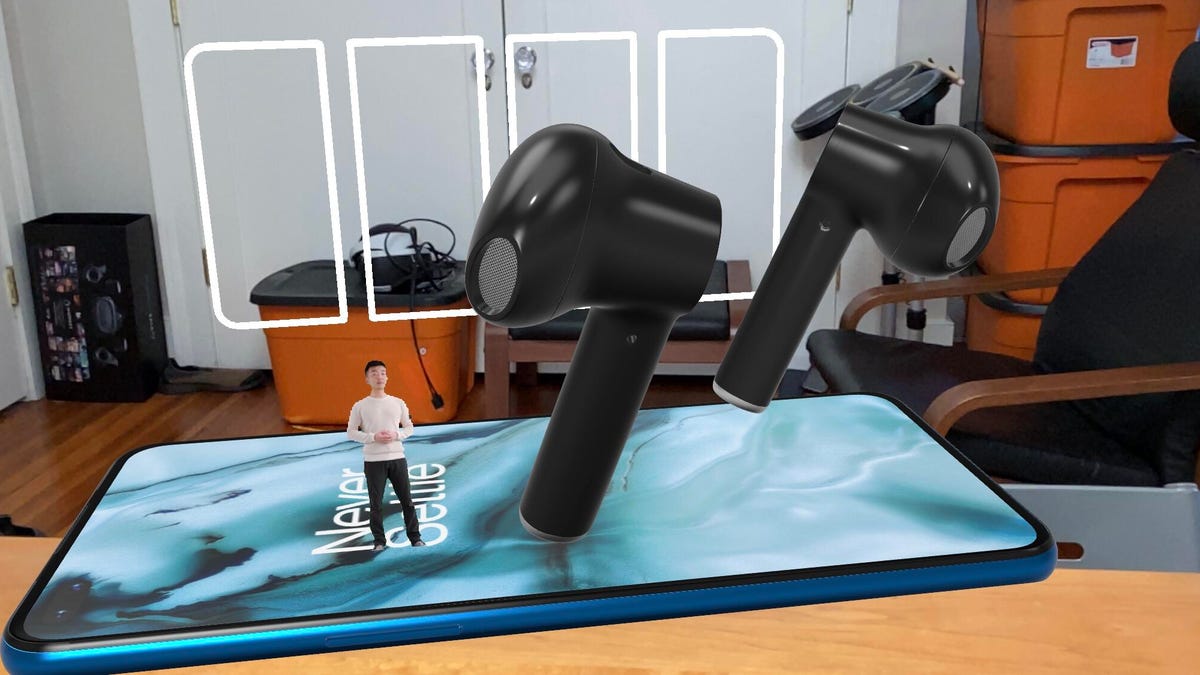I attended the OnePlus press conference... in augmented reality
In a future with smartglasses, it made sense. As it is, it was weird, and also fascinating.

There's a mini Carl Pei on my desk, and a giant pair of OnePlus Buds.
I turned into a photographer halfway through a press event that took place somewhere above my desk. OnePlus ' new wireless OnePlus Buds were hovering in front of me, seen through my phone screen using augmented reality tech. I could turn and look at them from different angles. I got super close. And I started taking product shots. Screenshots, yes, but I could lean in and see details that I would normally want to discover at an in-person event. Maybe I got a taste of how many events will take place in the next several years. And if ever there was an event in search of magic AR smartglasses, OnePlus' experiment in unveiling its new Nord phone and wireless earbuds on Tuesday was it.
The world has become a fast-forward experiment on virtual events, with and without headsets. I've met virtually in imaginary classrooms with Microsoft, looked at VR headsets in VR, and been to countless Zooms and video chats. But OnePlus' attempt at an all-AR experience was something different, even for someone like me who's tried a lot of AR stuff.
You might think AR is a gimmick, and on phones and tablets it's hard not to feel that way. I didn't expect OnePlus to have an AR event in the works. But I checked it out using an iPhone , downloading the required app and joining in. The whole thing was prerecorded, but felt a lot like events I've attended in person or streamed: the audience full of avatars, the countdown timer, even a keynote delivered by a mini hologram of OnePlus Global Director Carl Pei.
The AR elements needed me to anchor a spot in my room where everything could center: My large messy desk worked, but sometimes I had to quit out and center again. A floating TV screen showed videos, which felt cool and a bit ridiculous. I'm watching on a screen. And now I'm watching a virtual screen within my screen.
The phone's details were laid out in AR, but I had to get my angles right to take it all in on an iPhone.
More useful were the breakout sections, where the new OnePlus Nord phone was detailed, the phone splitting apart in 3D, allowing me an enhanced view of the parts inside. I could get closer to, and push my AR screen into, the mockup models of the phone and look at them from different angles. Unlike a flat keynote slide, I could explore. It wasn't like a virtual product demo, although OnePlus sent out cards with QR codes for people to have more virtual time with the product, but it was close.
I got more into the virtual rhythm during the company's wireless earbuds reveal. I shot pictures looking up, and down, and between. I got a sense of them, sort of.
The OnePlus Buds, floating in the air above my desk as I tried taking virtual product screenshot photos on the fly.
What I really wanted was to sense the dimensions in 3D, and not to hold a phone up the whole time. Propping up a device to watch a whole presentation, even a half-hour one, is tiring. It certainly looked like OnePlus' message was to underline the importance of AR, something that Apple, Qualcomm, Google, Samsung and others are doing, too. All we're missing now are the glasses to view it.
Besides expensive, business-targeted devices like the Magic Leap and HoloLens, the promise of smaller phone-connected glasses isn't here yet. Also, unlike VR's experiments with cheaper Cardboard-like viewers years ago, AR doesn't have that either. All we do have is the AR that's possible by holding your phone or tablet up and making things appear on your screen.
I'd rather watch an unveiling while seated than hold up my phone the whole time. But most of all I'd rather wear smartglasses that could allow me to sit back for a whole virtual briefing. I had a virtual briefing in VR for Qualcomm's upcoming headsets, via an app by Spatial... but that required having a VR headset. And that experience had some crashes and bugs, too.
I don't think I've seen an AR-at-home presentation as ambitious as what OnePlus just attempted. And in a few years, maybe this is the model for how virtual events can actually take place, because I still can't picture going to a crowded in-person tech event anytime soon.
Correction, July 22: A previous version of this story misidentified the hologram AR executive. It was Carl Pei.

